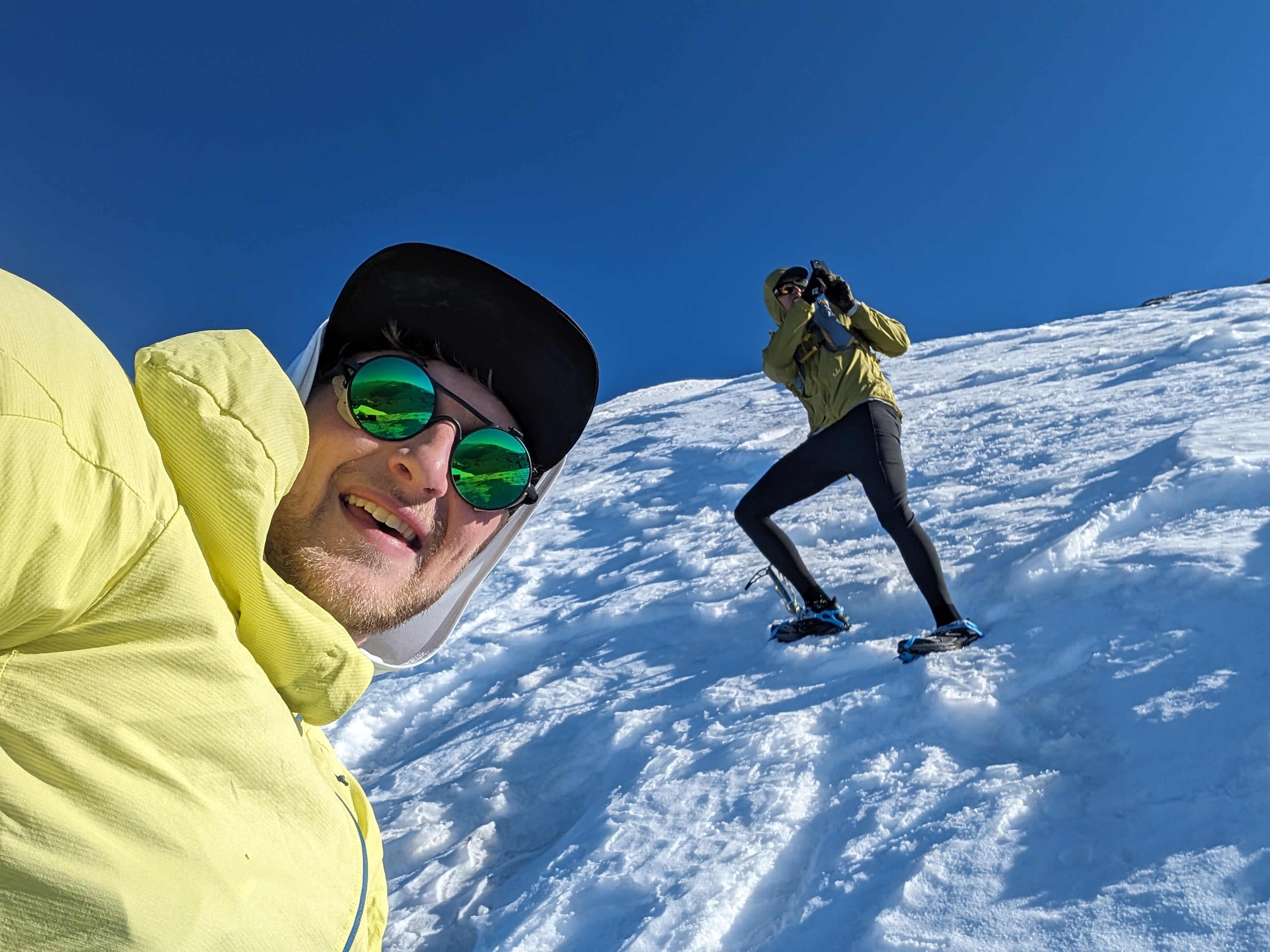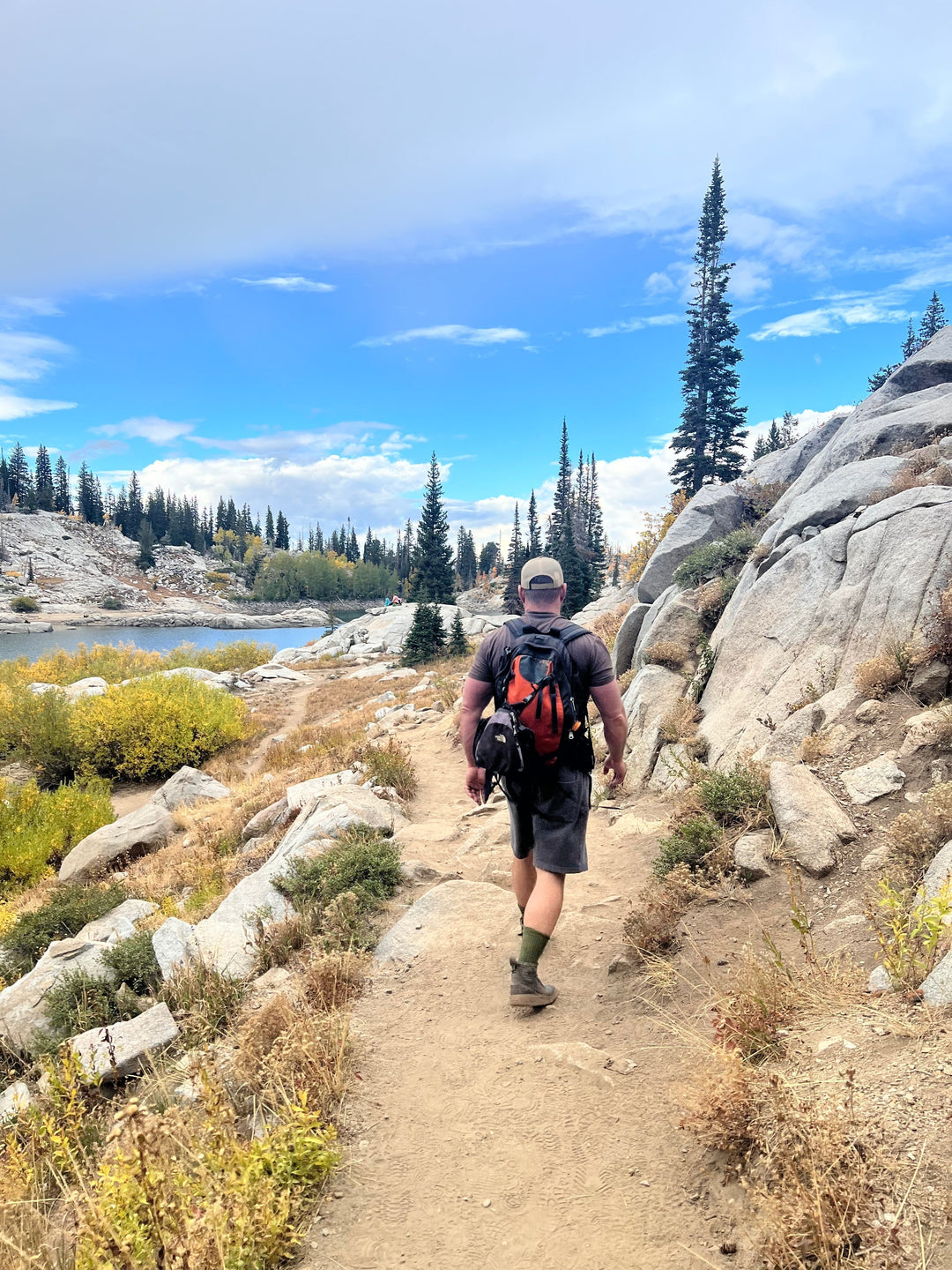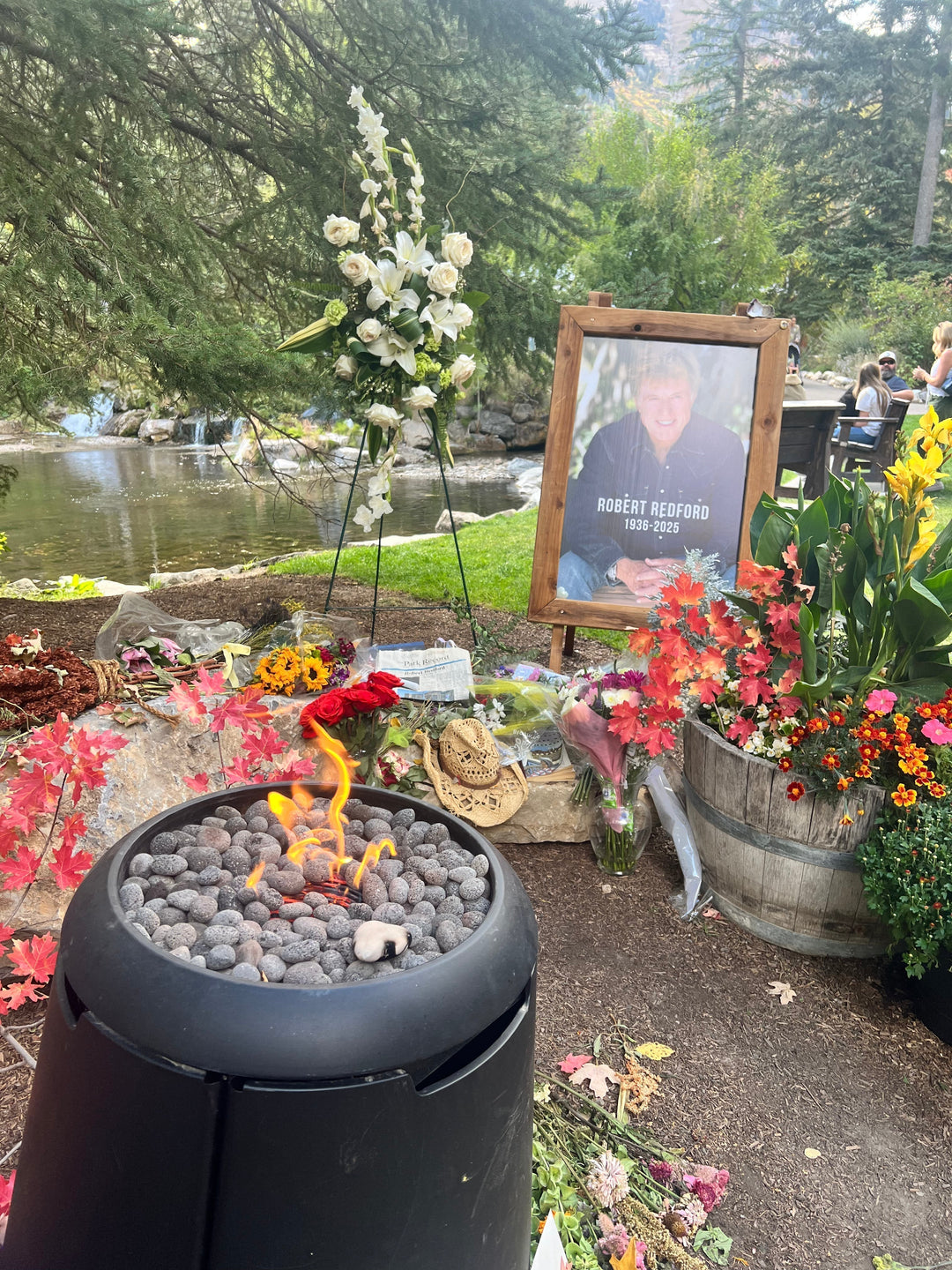Summiting the Snow-Covered Face of Mount Timpanogos

By Tyler Marshall
This wasn’t how it was supposed to go.
We were supposed to be on a classic adventure—not at war with the elements. We each self-assessed, and then looked around to gauge the status of the mountain. Rollers had crashed down to the bottom of the couloir. Not good. The couloir was to be our quick exit off. Now with surprisingly warm temps, and unstable snow conditions, we might be stuck.
*****
The sound of my alarm felt like I was suddenly dropped into freezing cold water. I arose, feeling a bit of shock. It was 4am. Foggy brained, I got myself ready as quickly as I could. I was already running late—classic—and messaged Kaden that I would be there asap.
Soon I was driving to the trailhead. I grinned. In spite of the difficulty of getting up, this was going to be an amazing day. It would be an adventure. The earliest month I’d ever ascended Mt. Timpanogos was early July. It was March 20th. Very few people ascended the mountain before the snow melted in July. And when they did they typically took the two well-worn trails on the back side of the mountain. We were summiting the face. Everest Ridge. The full route was roughly 11 miles, and just under 7,000 ft of vertical gain.
My pack wielded two different sized ice axes. It also contained crampons, water, and some dried fruit. Most often, my time in the mountains was spent running. Today the pack was heavier than I liked.
I met Kaden at a gate below the trailhead.
Kaden is around 6’6” tall. He has a certain tranquility that is odd in the context of how young he is. While I have more experience in the mountains overall, he’s spent more time in snow conditions than I have. The mountain game is one of inheritance. Becoming proficient, strong and safe in the mountains typically depends on an older generation taking the younger one under its wing. This was a unique opportunity to learn some snow and avalanche information from someone a bit younger than myself.
The gate was closed at the trailhead. Probably a good indicator that the conditions weren’t ready. However, we paid it no heed. We got ready and ascended the road with hopeful optimism.
We began climbing the dirt single track. The early morning was insulating. Everything outside our lamp beams was dark. Our casual chatter echoed off the trees, and the nearby cliff bands.
The approach is long. Our ridge bursts out of a fold, and climbs rapidly into the sky. It’s visible for miles around in the valley below. Our ridge sits proudly above another ridge. In essence, this day we had an approach to an approach. The first was a mile and a half long, with some 1,000 feet to climb up a canyon. Then comes the first ridge, which is stout by itself. It’s 1.25 miles long, and has 2,400 feet of gain.

Kaden and I climbed steadily, smoothly. We arrived at the first ridge. The air was stagnant. I had dressed for cold temps, and a lot of wind.
We moved up the stout climb. It was warm—way warmer than projected. I had an ominous feeling. I was sweating, and guzzling water to compensate. Not good. We each shed a layer, and proceeded up this first ridge.
*****
It’s odd: Kaden and I had never run together prior to this. Yet, we conversed without much pause. Mountain sports are strange in the way that they bond, and connect. A group of people in the mountains may have nothing more in common than a love for being there. Somehow connecting flourishes in this space. I’ve been in the elevated arena with real estate agents, business owners, college students, artists, carpenters, IT workers, and more. I’ve been there with people of diverse ethnic backgrounds, and of differing religious and political beliefs. Somehow, the magic of the mountains transcends all differences. It’s amazing.
Physical exertion in the mountains provides an overpowering perspective. This perspective illustrates human connection. I think that everyone is simply trying to make sense of the universe, and their place in it. Moving through the mountains mirrors this journey of self-discovery in everyday life. It is a process of tethering physical events to emotional experiences. Moving through the mountains helps reconcile these independent aspects of experience and perception. When done with others, a special bond will form.
Kaden and I reached the top of the first ridge at the first whisperings of sunrise. We’d encountered some mixed conditions, which weren’t nearly as good as projected. Still in the dark, we felt a little preemptively defeated. At the top, the sun peeked over the horizon. Its influence was immense, and worked quickly. It was an instant pick-me-up. We looked forward with hope, and pressed on.
About a half mile later, we were at the base of our objective. The main ridge! We grinned. I felt small beneath a 3,200 foot wall of more mountain.

Traditionally, the route from here goes south a half mile, and then abruptly climbs into a couloir. From there, it wraps above some cliff bands for access to the ridge.
We decided to climb straight up the ridge in the steep snow, and avoid the extra mileage. This was a bold move, due to the impending grade of the “trail.” The mountain smoothly transitions from a 5° grade to 25°, 45°, and briefly up to around 65°, before returning to a more consistent 15°-30° range just above the rock bands. We each drew an ice ax, and put on crampons. We climbed, and quickly reached the cliff band area. This was probably the crux of my day, in multiple ways. It was technical, sketchy; my heart rate rose, and my body pumped cortisol to a poetic, heart pumping rhythm. It alerted me to the obvious: I was nervous. It was a dangerous spot.
I used my ax, dug my crampons, and ascended this vertical spot. My fingers were either gripping the cold ax handle, or the snow in front of me. They grew stiff, and then felt painful as the blood ceased to enter them. The cold burned. Soon my stomach felt a searing discomfort. I got above this spot, and the grade chilled out a little. I made my way up to the spot where Kaden was perched. My mind raced. It tried to enter flight mode. I imagine I must have had a wild look in my eyes. Kaden, already aware of the answer, asked,
“You alright man?”
“My hands are freezing, and I think I’m going to throw up.”
“Do you think it’s the elevation?” Kaden asked. “Just take some deep breaths.”
I sat, breathed. I drew thin, cold air into my nose, and exhaled it out of my mouth. The breaths were slow, smooth, and focused. It was meditative, and I relaxed fairly quickly. I rotated my arms long in front of me, trying to force blood into my fingers. I ate a little. And drank a lot.
“You need anything man?” Kaden asked me.
I started to get up. “Let’s get moving,” I said, feeling gritty.
He didn’t ask me if I was sure!
We resumed moving, and made some nice progress up this tough ridge. I felt proud of myself. Calming the mind, and taking care of the self on the fly is difficult. Extreme situations like this are tedious, and it’s critical to not give the mind too much power over the body. I’m more practiced than I was.
We climbed. The ridge was immaculate.
The snow, unfortunately, wasn’t.
Some sections of the ridge were too icy. Others were soft, and gave way to post-holing. We’d hoped for a perfect, grippy top layer. We quickly realized we were too early for the route. All the beta we’d read hadn’t been accurate.
We continued, powered by the hope that we could attain the summit. It was getting nearer, and, in spite of the conditions, we made decent progress. The climb was laborious. We dug into the snow with our tools in a rhythmic beauty. To travel in these conditions, one stabs the snow ahead of them with the bottom of the ax. Then you proceed one foot at a time, downside foot, slopeside foot. Rinse, repeat. Stab, step step. Stab, step step. It moves like traditional Homeric dactylic hexameter. (What a mouthful!) The mountain keeps the beat with sonorous noise reflection. It is poetic, and relaxing. Stab, step step.
The air got thin. We could see Timp’s ridgeline just above us. My stoke was high. I was feeling great, and knew I could summit.

Suddenly, we topped out below the crest of the line above. Kaden was above me, stalled. The section we were on had become extremely icy, and the grade was no joke. Kaden looked down and shook his head. We’d decided to wear running shoes in our crampons so that we could move quicker. It should’ve been fine, based on the beta we’d read for the day’s conditions. Unfortunately, Kaden’s shoes were particularly soft. Kicking into the snow layer had become nearly impossible for him. We paused. Going down would be tenuous. Going up had become impossible.
This wasn’t how it was supposed to go. We were supposed to be on a classic adventure --not at war with the conditions. We each self-assessed, and then looked around to gauge the status of the mountain. Rollers had crashed down to the bottom of the couloir next to us. Not good. The couloir was to be our quick exit off. Now with surprisingly warm temps, and unstable snow conditions, we might be stuck.
We stayed put and talked for a few minutes. What to do? We wanted to summit. To that point, we’d climbed well over 6,000 feet. How could 200 more possibly be a problem?! Yet, they were. We discussed every possibility. The reality was disappointing. We didn’t have the safety margin to ascend more, or to descend into the couloir.
Tough.
*****
We had to turn around. We had to descend the ridge. It was slow going, and unnerving at first. The ice refused my crampons. I had to dig, and tediously step down, clinging to my ax. After some tense down climbing, the ice started to soften. We could breathe a little easier. The ice became snow, and we were able to move with consistency.
We’d made the right call.
Those moments between what’s happening, and what will happen can be scary. The key is to respect the mountain, and to not panic. We made the best choice under all considerations, and found safety in doing this.
Mount Timpanogos wasn’t going anywhere. There was always another day.







What a thrilling story! I was gripped. Glad you made the right call and can hike another day. I had a “Timp wasn’t going anywhere” moment too once. And a “these conditions aren’t great” moment too. (These were 2 different times!). Glad I made it off the mountain safely both times, and yeah, I hiked it again another day. Cheers to more Timp hikes!
‘I grinned’: classic! That’s where I heard the voice in this article. I’m excited to read the experience of you guys summitting
Leave a comment